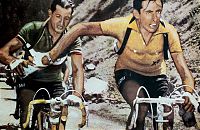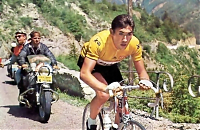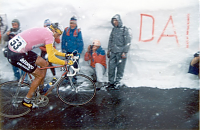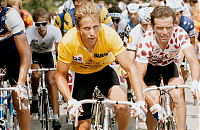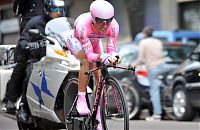Velo Power

“Glide Along Little Lassie”
The bicycle, according to scholar Donald Zaldin, revolutionized nineteenth-century culture. Its progenitor was the two-wheeled velocipede, invented in 1817 by Germany’s Baron Karl von Drais. The velocipede looked like a bike, but it had no crankshaft or drive train. The rider was propelled along by foot power alone. Then, sometime in the mid-1860s, a French metalworker figured out how to add a crankshaft. Two decades later, in 1885, England’s John Kemp Starley attached gears to the rear wheel instead of the front. Three years later, John Boyd Dunlop, a Scottish veterinarian, improved pneumatic tires and introduced the smooth ride. Suddenly, anyone, rich or poor, young or old, could travel beyond his or her immediate surroundings at no extra cost and with little wear on the body. The past century has seen numerous design upgrades and innovations — the three-speed Raleigh, the ten-speed derailleur, the mountain bike, the hybrid — but the concept remains the same.
And that concept’s irreducible nut is the body defying gravity. Riding is governed by physics, specifically by torque-induced precession. Gravity causes a stationary bike to fall over, but applying torque — using the legs and feet to push down on two pedals attached to a crank — changes the equation. The drive train transfers the rider’s energy directly into movement. The wheels turn and stay upright, and torque allows 182 pounds of human tissue to move on two flimsy pieces of rubber filled with air.
The thinner the bicycle’s frame, the less wind resistance, and aerodynamics only increases efficiency; leaning over the handlebars, especially going downhill, reduces drag and boosts speed. Spoked wheels are almost as strong as solid ones, at a fraction of the weight. Using a derailleur, a transmission system invented by the French in the late nineteenth century, the rider easily switches the chain to a smaller sprocket and — voila! — more torque, more distance in less time. As the rider increases cadence — the number of revolutions per minute — he injects pure power, especially in higher gear ratios. The work is hard but satisfying.
Source – Switching to Glide
Contrail

“Hansel and Gretel Cycling”
Contrail is a tool for developing bicycle communities. As you ride, contrail leaves a faint chalk line behind your bike. The goal is to encourage a new cycle of biking participation by allowing the biking community to leave a unique mark on the road and to reclaim this crucial shared space.
Want to know more?
If you’re interested in receiving periodic updates about Contrail’s progress and availability, please leave us your email address–we won’t use it for anything but sending you breaking Contrail news.
Source- About Contrail
A Cool Way To Get Around

“A Modern Bicycle with a Classical Touch”
Think of it as a beach cruiser on steroids—a “Muscle Beach” cruiser, if you will. There’s nothing metrosexual about this Eurostyle city bike—it’s updated from a Swedish army bicycle of the 1940s, and it would not look at all odd with a carbine scabbarded to its fork. Pure, manly utility: steel and plenty of it; big 650B tires for floating over broken roads, debris, and dirt; fenders to keep the “mud, the blood, and the beer” off your blue jeans; and a rear rack you could strap a keg to. It’s 100% at home in the big, bad city: laughs at potholes, sneers at alleys, rolls with the slow grace of someone who knows he’s got nothing to fear. If it were a car, it would be a Checker Marathon, staple of the New York City taxi fleets in the 1950s and ’60s. It’s an old Irish cop of a bicycle, right out of Raymond Chandler. (Ladies, fear not: there’s a women’s frame available as well, for the shorter and the skirt-clad amongst us)
Source- About the Kronan




